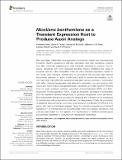Files in this item
Nicotiana benthamiana as a transient expression host to produce auxin analogs
Item metadata
| dc.contributor.author | Davis, Katharine | |
| dc.contributor.author | Gkotsi, Danai S. | |
| dc.contributor.author | Smith, Duncan R. M. | |
| dc.contributor.author | Goss, Rebecca J. M. | |
| dc.contributor.author | Caputi, Lorenzo | |
| dc.contributor.author | O’Connor, Sarah E. | |
| dc.date.accessioned | 2020-12-07T15:59:19Z | |
| dc.date.available | 2020-12-07T15:59:19Z | |
| dc.date.issued | 2020-11-20 | |
| dc.identifier | 271534498 | |
| dc.identifier | dec54f36-1349-47d3-88e8-a69a23b0da3a | |
| dc.identifier | 85097224886 | |
| dc.identifier | 000596051800001 | |
| dc.identifier.citation | Davis , K , Gkotsi , D S , Smith , D R M , Goss , R J M , Caputi , L & O’Connor , S E 2020 , ' Nicotiana benthamiana as a transient expression host to produce auxin analogs ' , Frontiers in Plant Science , vol. 11 , 581675 . https://doi.org/10.3389/fpls.2020.581675 | en |
| dc.identifier.issn | 1664-462X | |
| dc.identifier.other | Bibtex: 10.3389/fpls.2020.581675 | |
| dc.identifier.uri | https://hdl.handle.net/10023/21114 | |
| dc.description | Authors gratefully acknowledge the Max Planck Society, ERA-IB project NBCPBH-EIB.13.008 (SO’C and RG) and ERC 788301 (SO’C). | en |
| dc.description.abstract | Plant secondary metabolites have applications for the food, biofuel, and pharmaceutical industries. Recent advances in pathway elucidation and host expression systems now allow metabolic engineering of plant metabolic pathways to produce “new-to-nature” derivatives with novel biological activities, thereby amplifying the range of industrial uses for plant metabolites. Here we use a transient expression system in the model plant Nicotiana benthamiana to reconstitute the two-step plant-derived biosynthetic pathway for auxin (indole acetic acid) to achieve accumulation up to 500 ng/g fresh mass (FM). By expressing these plant-derived enzymes in combination with either bacterial halogenases and alternative substrates, we can produce both natural and new-to-nature halogenated auxin derivatives up to 990 ng/g FM. Proteins from the auxin synthesis pathway, tryptophan aminotransferases (TARs) and flavin-dependent monooxygenases (YUCs), could be transiently expressed in combination with four separate bacterial halogenases to generate halogenated auxin derivatives. Brominated auxin derivatives could also be observed after infiltration of the transfected N. benthamiana with potassium bromide and the halogenases. Finally, the production of additional auxin derivatives could also be achieved by co-infiltration of TAR and YUC genes with various tryptophan analogs. Given the emerging importance of transient expression in N. benthamiana for industrial scale protein and product expression, this work provides insight into the capacity of N. benthamiana to interface bacterial genes and synthetic substrates to produce novel halogenated metabolites. | |
| dc.format.extent | 9 | |
| dc.format.extent | 683275 | |
| dc.language.iso | eng | |
| dc.relation.ispartof | Frontiers in Plant Science | en |
| dc.subject | Indole-acetic acid | en |
| dc.subject | Halogenase | en |
| dc.subject | Combinatorial biosynthesis | en |
| dc.subject | Auxin | en |
| dc.subject | Unnatural natural product | en |
| dc.subject | New to nature products | en |
| dc.subject | QH301 Biology | en |
| dc.subject | DAS | en |
| dc.subject.lcc | QH301 | en |
| dc.title | Nicotiana benthamiana as a transient expression host to produce auxin analogs | en |
| dc.type | Journal article | en |
| dc.contributor.institution | University of St Andrews. School of Chemistry | en |
| dc.contributor.institution | University of St Andrews. Biomedical Sciences Research Complex | en |
| dc.contributor.institution | University of St Andrews. EaSTCHEM | en |
| dc.identifier.doi | https://doi.org/10.3389/fpls.2020.581675 | |
| dc.description.status | Peer reviewed | en |
This item appears in the following Collection(s)
Items in the St Andrews Research Repository are protected by copyright, with all rights reserved, unless otherwise indicated.

